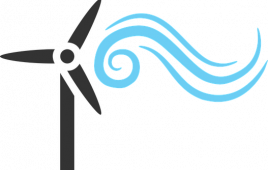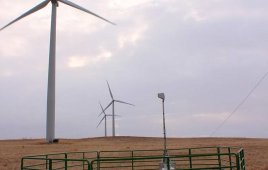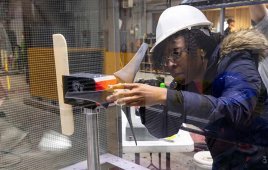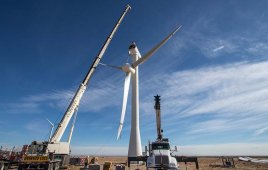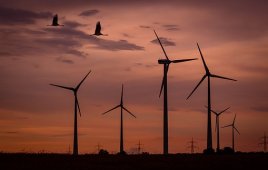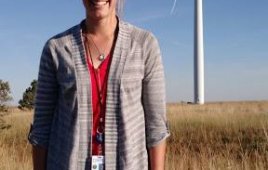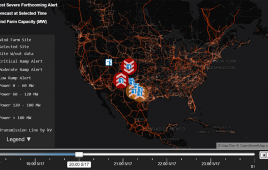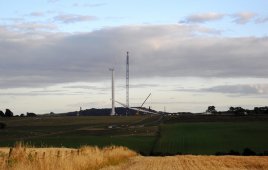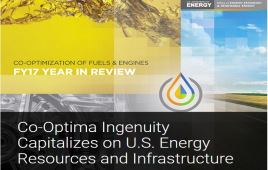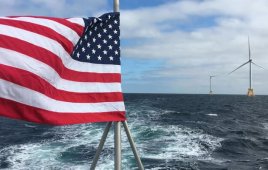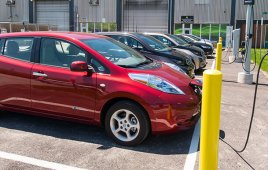The U.S. Department of Energy’s (DOE’s) National Renewable Energy Laboratory (NREL) plans to issue a Request for Proposal in mid-September for colleges and universities interested in participating in DOE’s Collegiate Wind Competition 2021, which is designed to help prepare students from a variety of backgrounds for a career in wind energy. By March 2020, organizers will select…
NREL field trials validate wind-turbine wake steering impacts
With funding from the Department of Energy, the National Renewable Energy Lab (NREL) has developed the FLOw Redirection and Induction in Steady State (FLORIS) model to help wind plant operators optimize turbine interactions. This open-source software lets users design controllers that can choose the best yaw angles for wind-turbine operation under different conditions. (Read more…
NREL addresses the wind energy workforce gap
A new report from the National Renewable Energy Laboratory (NREL) assesses the national wind energy workforce and the hiring needs of the industry. Entitled, “The Wind Energy Workforce in the United States: Training, Hiring, and Future Needs,”PD the report reviews the educational programs that are preparing students for work. According to the NREL, the researchers…
NREL researchers examine potential of taller turbine towers
In a new study by the National Renewable Energy Laboratory (NREL), Increasing Wind Turbine Tower Heights: Opportunities and ChallengesPDF, researchers examine opportunities for increasing the height of wind turbine hubs — where the turbine drivetrain and rotors attach — and the conditions and locations where taller towers would have the most impact. Taller towers can…
Department of Energy to fund NREL’s wind-wildlife mitigation efforts
The National Renewable Energy Laboratory (NREL) recently received U.S. Department of Energy (DOE) funding to reduce environmental impacts of wind energy by improving the effectiveness of ultrasonic acoustic deterrents technology. These devices emit frequencies perceptible to bats to discourage them from approaching wind turbines. Other technological innovations include thermal imaging cameras and specially developed radar…
NREL selects participants for 2019 Executive Energy program
The U.S. Department of Energy’s National Renewable Energy Laboratory (NREL) has selected 21 leaders to participate in its 2019 Executive Energy Leadership program. This “Energy Execs” program provides non-technical business, governmental, and community leaders an opportunity to learn about advanced energy technologies, analytical tools, and financing to guide their organizations and communities in energy-related decisions…
National Offshore Wind Consortium seeking R&D proposals
The National Offshore Wind R&D Consortium, established by Department of Energy’s (DOE) Wind Energy Technologies Office (WETO), has announced the availability of funding for additional offshore wind research and development topics. The consortium is still accepting applications for offshore wind plant technology advancement R&D funding, which was announced in March 2019. Topics include: 1. Offshore wind…
A glimpse inside the life of wind research engineer, Jennifer King
There’s an old proverb that states, “He who does not research has nothing to teach.” To her credit, Jennifer King has plenty of insight to share on wind energy and she has years of research to back it up. She’s currently a research engineer at the National Wind Technology Center, which provides research facilities and…
New computer modeling research increases accuracy of wind-turbine wake simulation
Researchers at Sandia National Laboratories (Sandia) and National Renewable Energy Laboratory (NREL) are using advanced national supercomputing resources to develop an open-source computational fluid dynamics (CFD) code that simulates wind plants with greater accuracy than previously possible. This Nalu-Wind code is emerging as the foundation for next-generation wind power plant flow modeling, enabling operators and developers to…
NREL delivers industry-shifting software for visualizing wind forecasts
Electric grid operators need the ability to plan generation to meet load, whichever way the wind blows. This means that they need access to real-time information — easily navigable and visually coherent — to truly build an intuition around wind power. They now have access to such information with WindView, a tool for visualizing wind…
What’s new in wake-effect research for wind farms
Size matters when optimizing for wind-turbine production. Taller towers with longer blades typically capture greater, stronger winds for power generation. However, turbine size is only one important feature of a successful wind farm. Siting and turbine placement at a wind site is also critical. And according to researchers at UC Santa Barbara, wind turbines rarely…
New research on wake effects shows significance of careful wind siting
New National Science Foundation and Department of Energy-funded research highlights a previously unexplored consequence of the global proliferation of wind energy facilities: a wake effect from upwind facilities that can reduce the energy production of their downwind neighbors. In collaboration with the National Renewable Energy Laboratory (NREL), faculty at the University of Colorado Boulder (CU)…
Vehicle simulation tool allows wider array of analyses
Editor’s note: This article, from NREL on May 22, 2018, should be of interest to wind industry advocates because the 21st-century transportation fleet will be powered more by renewable energy derived fuels such as hydrogen and batteries. But before that, the fuel must be electrolyzed and stored, and that will call for wind-generated power. New…
EVI-Pro Lite software assists with electric vehicle infrastructure planning
NREL has created a new tool called EVI-Pro Lite to assist communities anticipating growth in plug-in electric vehicles (PEVs). The tool identifies existing public electric vehicle charging infrastructure by state or city/urban area and estimates the quantity and type of infrastructure necessary to support increased regional adoption of electric vehicles. EVI-Pro Lite is a simplified version of…
NREL helps Canada create Electric Charging and Alternative Fueling Stations Locator
National Renewable Energy Laboratory (NREL) teamed up with Natural Resources Canada (NRCan) to create the Electric Charging and Alternative Fueling Stations Locator, a Canadian version of the lab-developed Alternative Fueling Station Locator. The tool, which is part of a significant investment by the Canadian government to expand the country’s electric and alternative fueling infrastructure, ensures drivers and […]
KULR Technology licenses award-winning battery internal short-circuit device
Under agreement with National Renewable Energy Laboratory (NREL), KULR Technology will be the exclusive manufacturing, distribution, and marketing partner for the patented, award-winning Battery Internal Short Circuit (ISC) Device to industrial, research, and design clients. Developed by NREL and NASA, the Battery ISC Device revolutionizes the way lithium-ion (Li-ion) batteries are evaluated so designs can be improved […]
Wind turbines in extreme weather: Solutions for hurricane resiliency
In addition to the wind hitting the turbine and a hurricane, the turbine’s foundation also has to contend with large, powerful waves.
Developing national offshore wind standards in the U.S.
A solid offshore wind industry offers great potential and benefit to the United States. In fact, according to the Department of Energy (DOE), if the country could develop 86 GW of offshore wind by 2050, it would create at least 120,000 jobs, cut greenhouse-gas emissions by 2.8%, and provide American with much-needed clean energy. The…
Wind on the waves: Floating wind power becoming a reality
As the United States looks to deploy more offshore wind, several U.S. specific technical challenges will need to be overcome, especially for floating wind facilities.
Argonne & partners improving EV batteries. Their goal: a 10 min charge
Researchers from INL will join Argonne in battery testing and electrochemical charging characterizations while NREL researchers will conduct thermal characterization tests and work with Argonne on battery cell modeling.

